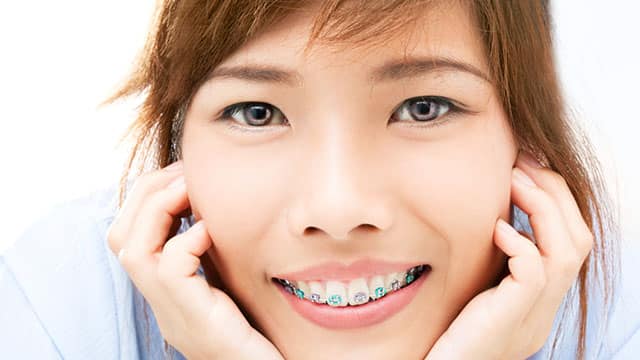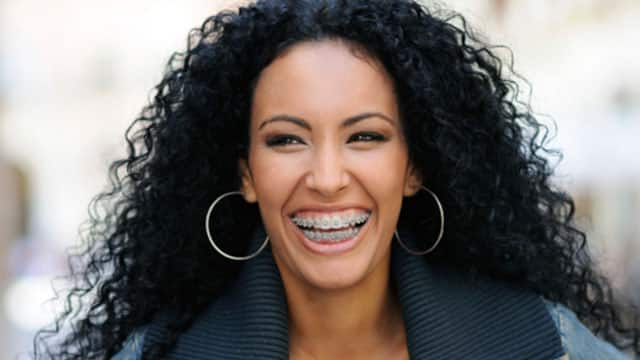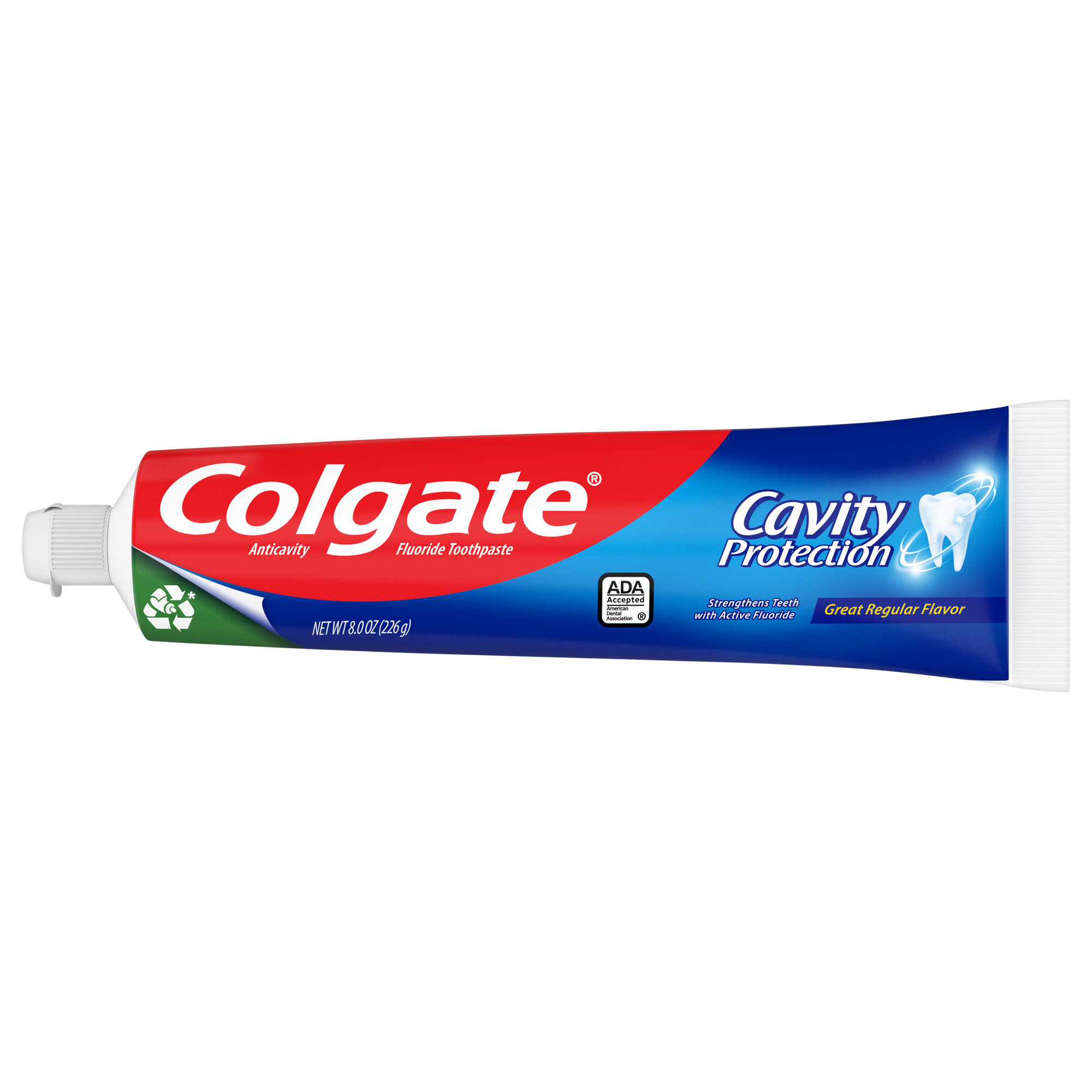Reasons To Get Braces
Adults decide to get braces for several reasons, which include:
- Crooked or misaligned teeth. Misaligned and uneven teeth can interfere with a healthy bite. Misalignment can lead to excessive tooth wear, gum disease, tooth decay, jaw problems, and chipped teeth.
- Mouth size. A smallmouth can cause tooth crowding, while a large mouth can cause larger spaces between teeth.
- Aesthetics. Many people do not like the look of their smiles and would prefer teeth that look straighter or more even.
Types of Adult Braces
When you visit your orthodontist, you can speak to them about the various options for straightening adult teeth. Whether you choose to have the more traditional braces that adhere to your teeth or a removable aligner, you have the availability to select braces that best fit your lifestyle. Today, there are several inconspicuous options for adult braces:
- Removable aligners, also referred to as clear aligners, you wear throughout the day and night. You can remove them when needed, such as when you eat or attend events like business meetings or special occasions. For treatment with aligners, the orthodontist takes an impression of your teeth and makes multiple sets of computer-generated custom-fitted aligners for you to wear. You change to a new set of aligners every few weeks as the teeth move - then put in a new set of aligners. The aligners are clear, so they are barely noticeable!
- The installation of ceramic or clear braces is directly on your teeth, just like traditional braces. They are less noticeable because the brackets and pieces attached to the teeth are tooth-colored ceramic material.
- While a dentist will attach lingual braces behind your teeth, so they're not noticeable!
What to Expect While Wearing Braces
Brushing With Braces
It's imperative to create an excellent oral hygiene routine when taking care of braces as an adult. Brush your teeth after every meal and snack, not just the recommended twice a day. It's important to brush each tooth at the gumline and below the brackets to minimize potential plaque between the teeth and braces
Other Cleaning Methods
Flossing, also known as interdental cleaning, is critical at least once between the teeth and under the wires. To more easily floss under the wires, use a floss threader or orthodontic flosser, which you can buy at drug stores. Waxed floss may be more comfortable to slide between your teeth and less likely to snag on your braces than unwaxed floss.
If you have space between your teeth, you might find an interdental brush that goes between the teeth works better than flossing. Another option for hard-to-reach areas is water irrigators. Its stream of pulsating water can remove plaque and food debris. Rinsing with mouthwash to kill any bacteria missed by brushing and flossing is always a great last step!
Watch What You Eat
As you've figured out by now, when you have braces, your teeth need extra attention to protect them from decay, staining, and gum disease. It is best to take precautions to avoid damaging your braces. For example, activities to avoid include eating chewy, hard, or crunchy foods, biting your lip, breathing excessively through your mouth, and pushing your tongue against your teeth. To eat crunchy foods, cut them into small, bite-size pieces
Additional Tips for Braces
If you find yourself in a situation without a toothbrush after a meal, vigorously rinse your mouth with water (or mouthwash). If your braces or wires chafe the inside of your lips, you can place dental wax on them to prevent this from happening. You can get this wax at drug stores or ask your dentist or orthodontist.
Special Considerations For Wearing Braces As An Adult
Age-Related Bone Structures
While adults have more options for the types of braces they can choose from, there are age-related considerations when deciding to get braces. You and your dental professional should consider bone structure, bone loss, and the length of time you will need braces.
Unlike a child's mouth, the bones in an adult's mouth have stopped growing. You may have a structural issue that cannot change with braces, only surgery. Your dental professional should look for any bone loss before you consider braces. Bone loss, resulting from gum disease, could be a complication for braces as well.
Tooth Extraction Issues
Many adults have had one or more teeth extracted in the past, presenting a problem for your orthodontist. These sites, unless restored, are not suitable locations for teeth to be moved into by braces. Closing gaps between the teeth caused by extractions can be tricky because adult bone doesn't respond to pressure in the same way as growing bone.
Appliance Placement
Many adult orthodontic appliances, like lingual braces, bond to your teeth with dental cement. Cement on your teeth makes it vital for you to maintain strict oral hygiene during the process.
Root Resorption
One of the risks associated with orthodontic treatment is the development of root resorption. Root resorption is the gradual loss of tooth structure, which weakens the support of your tooth. Root resorption is permanent, and a dental professional will not be able to fix it. Many factors increase the risk for resorption, including genetics, tooth and bone anatomy, chewing forces, and specific health problems. Factors related to orthodontic treatment include the power used to move your teeth, the direction your teeth will move, the type of orthodontic appliances used, and the duration and type of treatment techniques used. Your orthodontist will do a careful examination of your teeth to determine if any of your teeth may develop root resorption before starting orthodontic treatment.
Psychosocial Factors
It's also helpful to be mindful of the psychosocial factors that play a role in treatment and post-treatment. Several psychological and social factors affect adults interested in braces. You may be eager for perfect results, have concerns about their appearance, and question each step the orthodontist takes as well as the cost of treatment. It's normal to have questions or worries before a commitment to braces, especially as an adult. Keep in mind that your dentist is there to answer your questions and provide you with encouraging oral health suggestions along your journey!
Your experience with braces may last longer than what you remember your friends going through in middle and high school! Unfortunately, adults, on average, have a treatment that lasts about two years. The time required varies depending on your teeth' condition. Even though you should be prepared for more extended treatment, the results will be worth it!
What to Expect When Braces Are Removed
Retainers and Appliances
After the removal of your braces, your immediate impulse might be to take a photo! Who wouldn't want that classic adult braces before and after shot? But there's most likely one final process for achieving perfect teeth: a retainer. Orthodontists usually fit you for a retainer to keep your teeth from moving after the braces come off. They can either be removable or cemented in place behind your teeth, where they won't be visible.
Each retainer is custom fit to your new bite and will fit comfortably in your mouth. Caring for retainers is easy! Brush them regularly with fluoride toothpaste as a natural part of your oral care routine. You may need to use floss threaders or oral irrigators (also known as water flossing) to help clean under and around retainers that are fixed in place to keep your teeth and gums healthy. Your orthodontist will advise you about the right way to clean your retainers
Tooth Whitening
It's only natural that you'd want white teeth to go with your newly straight smile, right? In-office or at home are your two post-braces whitening process choices. But tooth whitening may not be an option after braces, especially if your teeth have white spot lesions or residual cement stuck to your teeth. The cement is not visible to the naked eye but will be highlighted if you whiten your teeth.
White spot lesions are decalcified areas of enamel that are caused by inadequate oral hygiene. So this is just another justification for maintaining excellent oral hygiene habits while wearing braces! A study in Contemporary Clinical Dentistry notes how using toothpaste and mouthwash containing fluoride may help prevent white spots. While nothing guarantees a perfectly white smile, a preventative oral hygiene routine can help.
Brushing
You've probably developed a perfect brushing routine after having braces, so why not keep up with it? Although brushing twice a day is the standard oral care recommendation for people who haven't had braces, you should continue to brush after every time you eat.
Age will not be a limiting factor if you're an adult who wants to correct your dental problems. It's exciting to have options for fixing your teeth later in life! Adults ultimately have more options for braces that include both permanent and removable appliances. Consider the above factors when deciding if you'll make the jump to get braces and what type. Like any big dental decision, the choice to receive orthodontic treatment is one that should be with your dentist's guidance.
This article is intended to promote understanding of and knowledge about general oral health topics. It is not intended to be a substitute for professional advice, diagnosis or treatment. Always seek the advice of your dentist or other qualified healthcare provider with any questions you may have regarding a medical condition or treatment.
ORAL HEALTH QUIZ
What's behind your smile?
Take our Oral Health assessment to get the most from your oral care routine
ORAL HEALTH QUIZ
What's behind your smile?
Take our Oral Health assessment to get the most from your oral care routine















